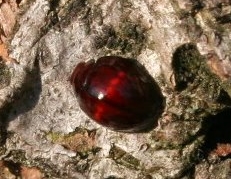Map Snapshot


1 Record
Status
BugGuide: "A native of Europe and the Middle East, this beetle has been introduced worldwide to control scale insects. In the United States, introduction attempts were made in 1905, 1915, 1927, and 1951, when a population finally became established in California.
The beetle cannot survive cold winters, but because it is locally released for biocontrol it may be encountered throughout North America during warm weather. This may account for BugGuide images from New Jersey, Maryland, and even as far north as British Columbia. All these images are from areas near major ports, so the beetles may also be adventive via international shipping."
Seasonality Snapshot
Source: Wikipedia
| Chilocorus bipustulatus | |
|---|---|

| |
| Scientific classification | |
| Domain: | Eukaryota |
| Kingdom: | Animalia |
| Phylum: | Arthropoda |
| Class: | Insecta |
| Order: | Coleoptera |
| Suborder: | Polyphaga |
| Infraorder: | Cucujiformia |
| Family: | Coccinellidae |
| Genus: | Chilocorus |
| Species: | C. bipustulatus
|
| Binomial name | |
| Chilocorus bipustulatus | |
| Synonyms[1] | |
| |
Chilocorus bipustulatus, the heather ladybird,[1] is a beetle species belonging to the family Coccinellidae, subfamily Chilocorinae.[1]
These beetles are found in most of the Palearctic realm,[2] (Europe, North Africa, Asia north of the Himalayan foothills, and northern and central Arabian Peninsula), [3] and has been introduced to tropical Africa, Hawaii, and North America.[4]
The elytra of this small beetle are a shiny brown with two reddish-orange spots on each elytron (hence the Latin word bipustulatus, meaning two-blistered). Sometime three spots run in an horizontal line and join into two larger stains.
The mature larva is about 5 millimetres (0.20 in) long. Wintering occurs as an adult. The adults grow up to 3–5 millimetres (0.12–0.20 in) long and can be encountered from May through October.
In Europe it occurs in fruit gardens, pine forests, and stone quarries.[5] In Poland it was found on grasses, low vegetation and bushes, on heath lands, under flakes of bark on pines and fruit trees, occasionally in leaf litter and in moss[6]
Heather ladybirds feed on aphids and scale insects (mainly belonging to the family Coccidae and Diaspididae) and is often introduced as a biological control in cases of infestation.[7][8]
References
[edit]- ^ a b c Biolib
- ^ Fauna Europaea
- ^ N. B. Nikitsky and А. S. Ukrainsky , 2016 The Ladybird Beetles (Coleoptera, Coccinellidae) of Moscow Province ISSN 0013-8738, Entomological Review, 2016, Vol. 96, No. 6, pp. 710–735 ISSN 0013-8738
- ^ ITIS
- ^ Koch, K., Die Käfer Mitteleuropas, Ökologie. Vol. 2 (Goecke und Evers Verlag, Krefeld, 1989).
- ^ Burakowski, B., Mroczkowski, M., and Stefańska, J., Katalog Fauny Polski. Szęść XXIII, Chrząszcze– Coleoptera. Tom 13. Cucujoidea, część
- ^ Commercially used biological control agents
- ^ Mansour, Rramzi; Mkaouar, Rim; Lebdi, Kaouthar Grissa; Suma, Pompeo; Russo, Agatino (2011). "A survey of scale insects (Hemiptera: Coccoidea) occurring on olives in Tunisia". Journal of Entomological and Acarological Research. 43 (3): 315–322.
External links
[edit]- Invertebrate Ireland On Line
- Bugguide
- Larva of C. bipustulatus Archived 2013-06-17 at the Wayback Machine

